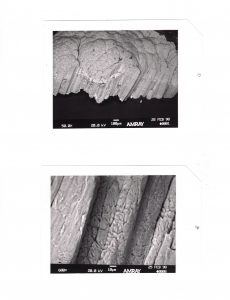 I received a sample of the magnisium-bismuth material that TTSA presently has under analysis from Art Bell in the mid-nineties. In February of 1998, it became possible for me to obtain an analysis of it from William Mallow, then the head of materials science at the Southwest Research Institute in San Antonio. Dr. Mallow examined some small metal objects and also a piece of what appeared to be slag, which proved to be layers of bismuth and magnesium. I am aware that some of this material was given to me and some to Linda Moulton Howe. Tom DeLonge of TTSA now has some of the material. It was not obtained from me.
I received a sample of the magnisium-bismuth material that TTSA presently has under analysis from Art Bell in the mid-nineties. In February of 1998, it became possible for me to obtain an analysis of it from William Mallow, then the head of materials science at the Southwest Research Institute in San Antonio. Dr. Mallow examined some small metal objects and also a piece of what appeared to be slag, which proved to be layers of bismuth and magnesium. I am aware that some of this material was given to me and some to Linda Moulton Howe. Tom DeLonge of TTSA now has some of the material. It was not obtained from me.
The SEM Scan revealed the material to be layers of bismuth and magnesium. The magnesium appears to be in a foamed state, with tiny bubbles within it. There is nothing about either the bismuth or the magnesium to indicate that it is in any way unusual, except that the condition of the magnesium was not familiar to Dr. Mallow. It appeared to be some sort of slag, or possibly residue from a Betterton-Kroll process, but this latter conclusion was dismissed because it does not explain the presence of the magnesium, and nothing explains how the materials remain together. The Betterton-Kroll theory has been repeated recently in media stories.
A number of micrographs of the material were obtained, of which one at 50x magnification and another at 600x magnification are shown here.
However, when imaged at 600x magnification in the scanning electron microscope, no adherent was observed between the bismuth and the magnesium. The areas between the alternating layers are clear of any substance. The conclusion was that, while the materials themselves were unremarkable, the fact that the amalgam was holding together despite there being no adherent could not be explained.
Subscribers, to watch the subscriber version of the video, first log in then click on Dreamland Subscriber-Only Video Podcast link.
This is pure speculation on my part, but the absence of a physical material binding the layers together brings to mind the possibility that the whole lump is being held together by a residual gravitational field, or some other such energy (like an artificial amplification of the Casimir effect)?
If the Mg is roughened the Bi can be melted into it to provide the physical adherence. This can be done in larger stages and then roll compacted to the thinner size. This has been done with glass-metal combinations where strong adherence is required.
Dr. Joseph Farrell (and other investigators, I believe) commented in one of his books that such a composite, especially the bismuth, reacts strongly to certain energy fields, thus possibly producing lift.
How exactly does the Betterton-Kroll process not explain the presence of Magnesium. It exactly explains the presence of Mg, as its whats used it the process to remove BIsmuth from Lead. That kind of condtradicts any conclusions came to based on that false misunderstand. This object is almost certainly industrial slag from that process. Not only did LMH original investigators tell her that, but so has Puthoff, Vallee, and probably others. They all determined its earthly industrial slag, not alien. And its not a meta-material. LMH thinks anything with nanometer layers or structures, makes its a meta-material. She couldnt be more wrong. The uninform, unstructured nature of this sample clearly shoes its not a machined or engineered material. But slag accumulation from an industrial process. Much like the ‘Bob White Object’ was just a stalagmite from a grinding wheel in a metal shop. Because some combination of elements is not sold as a commercial alloy, doesnt mean its otherworldy. Just that it wasnt designed or engineered intentionally that way. IE, its industrial waste.